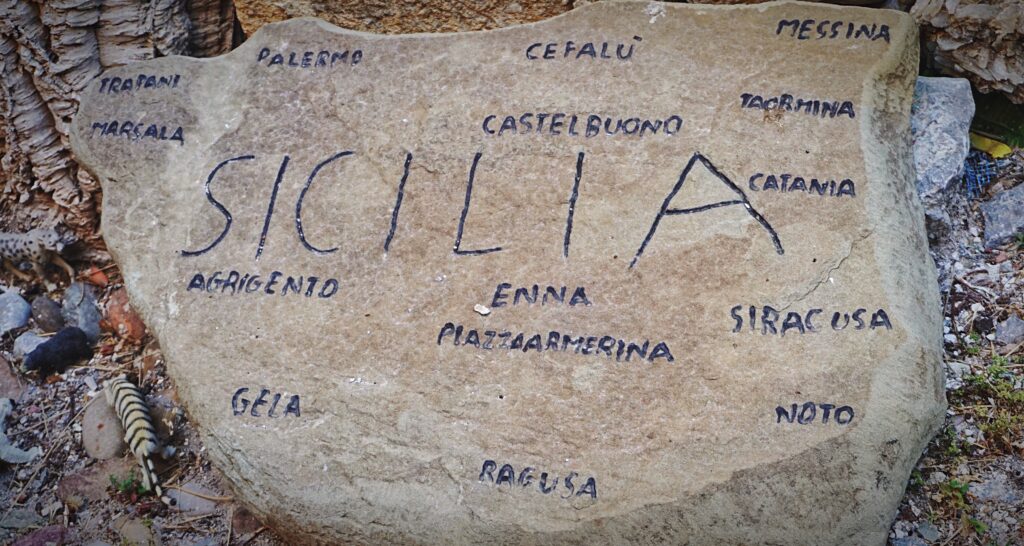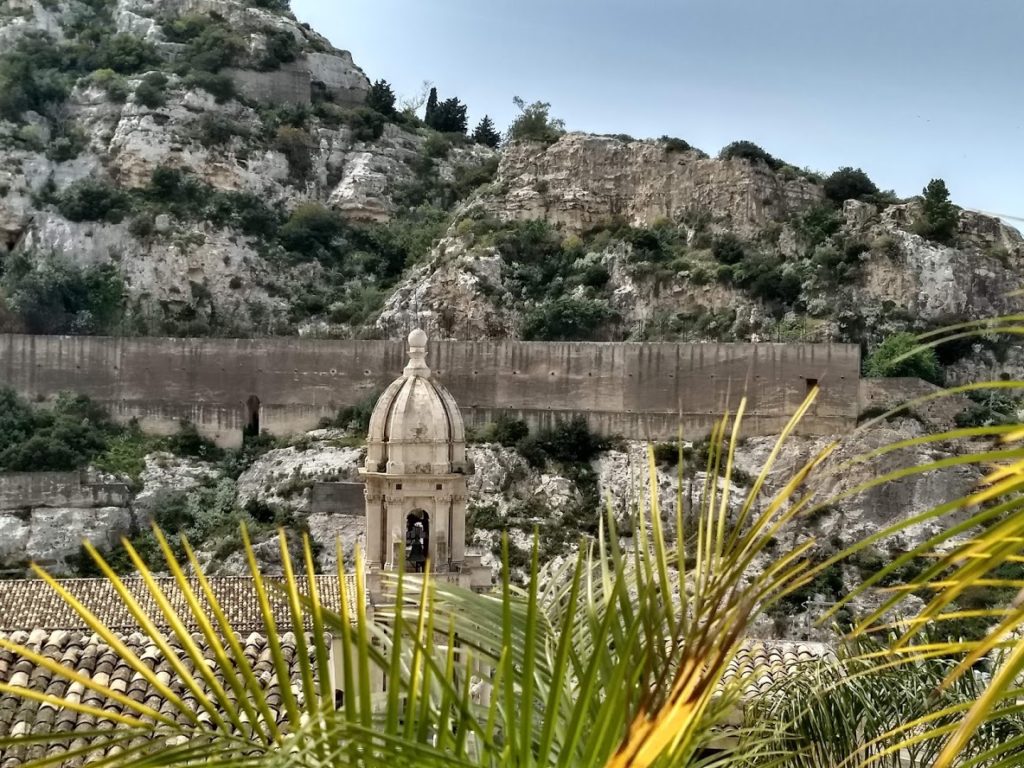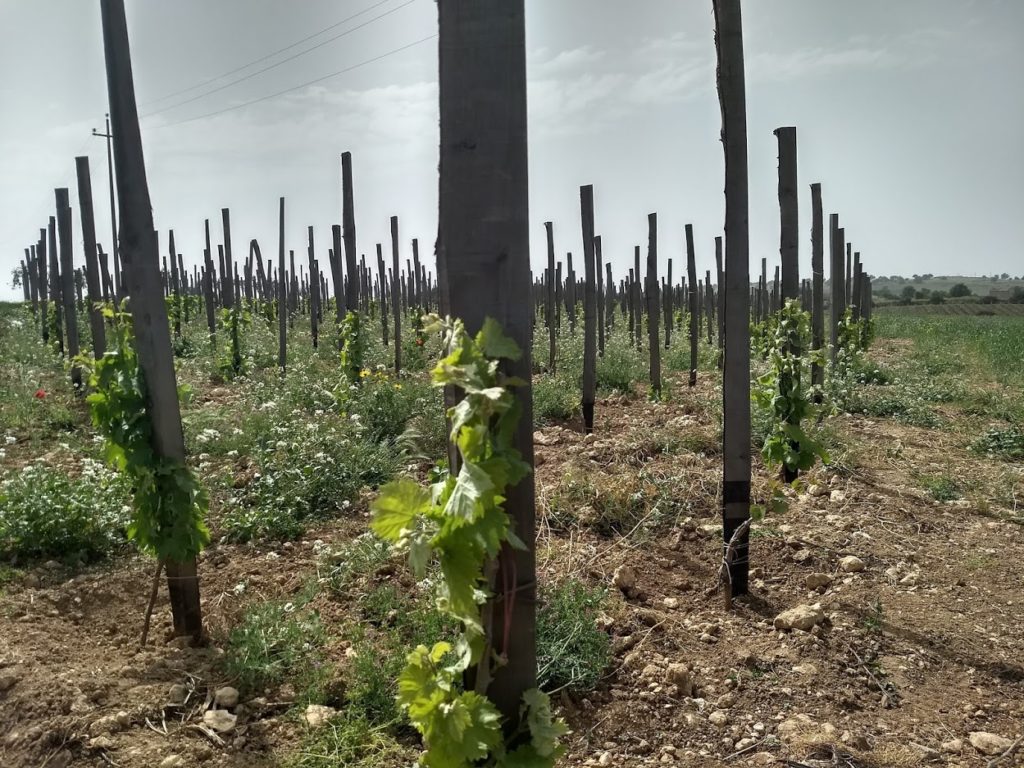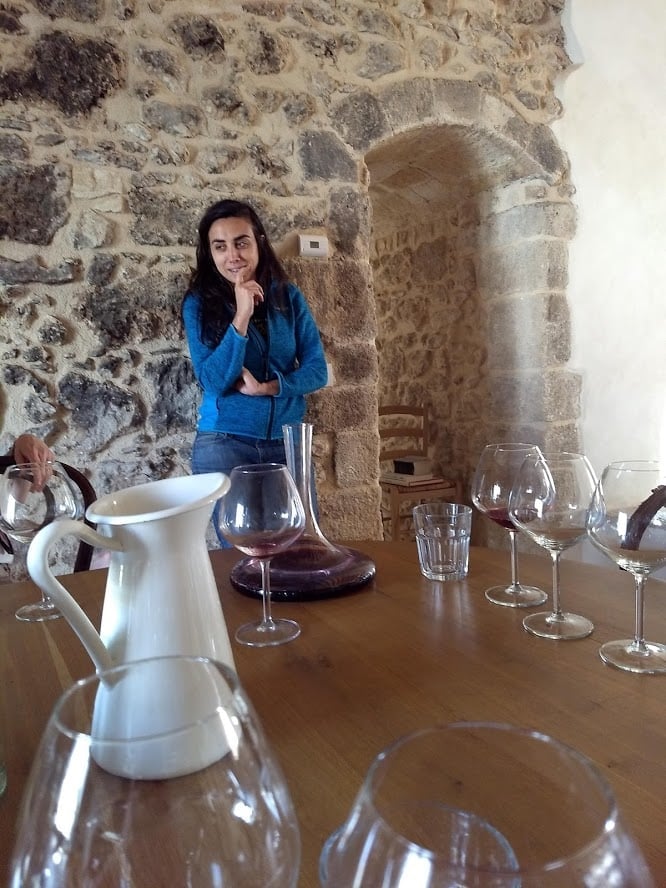Table of Contents
If waking up to a sage-scented ocean breeze sounds alluring, what about sipping coffee in an ancient fruit orchard while looking out over the crystal-blue Mediterranean? The Sicilian wine countryside seems to exist in another timeline.
A magical place, to be sure, but can any site be a paradise for long? A street sign is the only thing rarer than a GPS signal in Sicily. The shepherds and their sheep are quaint the first time they block the road for twenty minutes. And what do you do with that herd of cows that keeps breaking into your pasture, trampling your garden?

Table of Contents
A Short History of Wine in Sicily
In the 8th Century BCE, Greek colonists became the Island’s first winemakers. Ancient texts described Dionysus, the God of Wine, dancing as he planted the first grapevine in Sicily. Thanks to archeologists, we know these vineyards were located in the black hills under Mt. Aetna, a still-active volcano.

In time, the Romans conquered the island, which opened Sicily to the world. Merchants traded these wines as far away as modern-day France and Germany. Production boomed. A notable ancient wine was Marsala, a fortified wine on the western coast. A British merchant popularized the wine in the 18th century and soon compared it to Portugal’s Porto wines.
The history of Sicilian wines would likely have continued apace. However, in the late 19th century, an invasive parasite invaded the vineyards, killing most vines. The Phylloxera epidemic drew a stark red line between the 19th century and today.
In the last half of the 20th Century, Sicily recovered its winemaking mojo thanks to wineries like COS, Planeta, and Ceuso.
Sicilian Wine Regions
Province of Ragusa
Ragusa is the southernmost province of Sicily, situated in the Val di Noto. It has rolling hills, dramatic shorelines, and ancient towns. Ancient Greeks founded the town of Ragusa. In the 17th Century, an earthquake destroyed the town, which was rebuilt in the baroque style of the time.
Other important towns include Scicli and Modica. Like Ragusa, many of the buildings are in the Late Baroque style. The other key component of these cities is their culinary and winemaking traditions.

Cerasuolo di Vittoria
Cerasuolo di Vittoria is the most important appellation in Ragusa, dating back to the 7th century BCE. The name refers to an elegant refreshing style of wine. Cerasuolo refers to the light red hue of the wine. Vittoria is a city west of Ragusa and the center of the wine region.
The wine is an odd — but brilliant — coupling of two native varietals, Nero d’Avola and Frappato. Nero is an intense, hulk-ish red that produces angry and magnetic wines. Frappato makes a light, nearly pink wine with florals and ocean breezes.
The wine produced within an even more restricted area will have the appellation’s term “Classico” appended. The region was awarded DOC status in 1974. In 2005, Cerasuolo di Vittoria was upgraded to DOCG, the highest classification level in Italian wine.

Featured Ragusa Wineries
COS
COS is the acronym for the surnames of the Winery’s three founders: Giambattista Cilia, Giusto Occhipinti, and Cirino Strano. In 1980, these young men leased a small winery and vineyard from a family member. The first vintage produced a meager 1,470 bottles.
The volume increased yearly, but so did the quality and international acclaim. By 2000, they brought back an ancient Sicilian tradition: using amphorae (underground clay vessels) to age their wines. This technique has now been adopted across all of Italy, making them one of the best Sicilian wine producers.
Their best Sicilian red wine is a Cerasuolo di Vittoria named “Delle Fontane.” It is red ruby with cherry, blackberry, and currant aromas. The flavors of fresh roses and toasted spice are alluring, and the palate is fresh, elegant, and Mediterranean.

Arianna Occhipinti
The Arianna Occhipinti story is a more recent addition to the Sicilian wine scene. Arianna is the niece of Giusto Occhipinti, of COS fame.
She opened her eponymously named winery in 2004 in Ragusa. What began as a small one-hectare Sicilian wine operation now spans over 22 hectares, mostly Nero d’Avola and Frappato, with Albanello and Zibibbo, two local white varieties.
Her top-level wine is the Cerasuolo di Vittoria ‘Grotte Alte,’ aged at least 32 months in massive Slavonian oak buttes. The wine is an intense ruby-red color with garnet shades. The nose is fragrant, with details of sea spray, sour cherries, and oriental spices. The palate is intense and elegant, soft and round, with a persistent and salty aromatic finish.
The Arianna Occhipinti story is a more recent addition to the Sicilian wine scene. Arianna is the niece of Giusto Occhipinti, of COS fame.
She opened her eponymously named winery in 2004 in Ragusa. What began as a small one-hectare Sicilian wine operation now spans over 22 hectares, mostly Nero d’Avola and Frappato, Albanello and Zibibbo, two local white varieties.
Her top-level is the Cerasuolo di Vittoria ‘Grotte Alte’ i s aged a minimum of 32 months in massive Slavonian oak buttes. The wine is an intense ruby red color with garnet shades. The nose is fragrant, with details of sea spray, sour cherries, and oriental spices. The palate is intense and elegant, soft and round, with a persistent and salty aromatic finish.
Province of Trapani
Trapani is a Bronze-age commune that is still thriving in the modern era. Since the beginning of recorded history, it has been an important port for two Sicilian products, wine, and salt, on the island’s west coast.
A naturally protected inlet, Trapani can enforce naval superiority over a vast section of the Mediterranean. Over the past two thousand years, this sickle-shaped port has been the focus of countless wars and occupations.
From the Punic Wars of Ancient Rome to World War Two, this port drew dozens of ancient cultures into Sicily, only to be absorbed into the island’s culture. Phoenicians, Arabs, Romans, Normans, and Spaniards have all contributed to Sicily’s food and wine traditions.
The Wines of Marsala
Long before a wine bore its name, Marsala was an ancient city built on the ruins of an even more ancient city, Lilybaeum. Like much of Trapani, the town’s economy was based on its salt ponds and vineyards. By the 17th Century, the world’s economies were recovering from the centuries-long medieval depression.
Times were good, but the local winemakers had a problem: a growing wine market grew, but their white wines spoiled too quickly to ship. So they started using large oak barrels to store the wine, which helped. Then they heard of a new technique developed in Portugal: fortify the wine by adding spirit to the fermenting must. At about this same time, bottled wines became a status symbol. So a new wine was born.
The wine rose to fame in the early 20th century. During Prohibition, doctors prescribed Marsala for medicinal purposes for their wealthier patients. It wasn’t too long before there was more counterfeit Marsala than real. That fact, sadly, continues through today: most Marsala in American shops are pale imitations.
To seek out true Marsala, look for the term “Superiore Riserva” on the label. Sommeliers love the flavors of toasted almonds, fresh figs, and chocolate-coated raisins. They make for excellent aperitifs and the ultimate Sicilian sweet wine.

The Catania Region
Catania is the heart of Sicily: Mount Etna, the still-active volcano that the entire island is balanced upon. Located on the northeastern shore, Catania is famous for its black volcanic soils. Its buildings are built of the same stone, and its roofs are blackened by centuries of volcanic plumes.
The largest city is also named Catania and has been rebuilt dozens of times since its founding in 729 BCE. Unfortunately, the town has been destroyed by lava flows, earthquakes, wars, and social unrest.
How did a region so unlucky survive so long? It comes down to the lava flows: they cause so much despair and are why Catania thrives. Over centuries, lava rocks evolve into black volcanic soils that are fertile and life-sustaining. They are why Sicily is an agricultural wonderland.
The Wines of Etna
The first of the Sicilian wine regions was Etna. It earned DOC status in 1968, a full nine months before Marsala. This region’s important red grape varietal is Nerello Mascalese, crafting a complex but wild wine that often feels like a confluence of wild-grown fruit and a core of intense minerality.
The region’s whites include native varieties, including Carricante and Catarratto. The former produces light and ethereal wines that are straightforward with summer fish dishes. Catarratto is lush and intense, leaning toward tropical fruit infused with tarragon.
This place also attracts eccentric European winemakers with a zeal for unconventional methods. Just spend a few minutes with Frank Cornelissen’s wines, and you’ll understand Sicilian wine.
Frequently Asked Questions
What is the most popular wine in Sicily?
Coastal Sicilian cuisine is focused on fresh seafood, vegetables, and ricotta. The top grape in these regions is the white grape, Grillo. Moving inward, where you see more game and sausages, the red wine Nero d’Avola is much more popular
